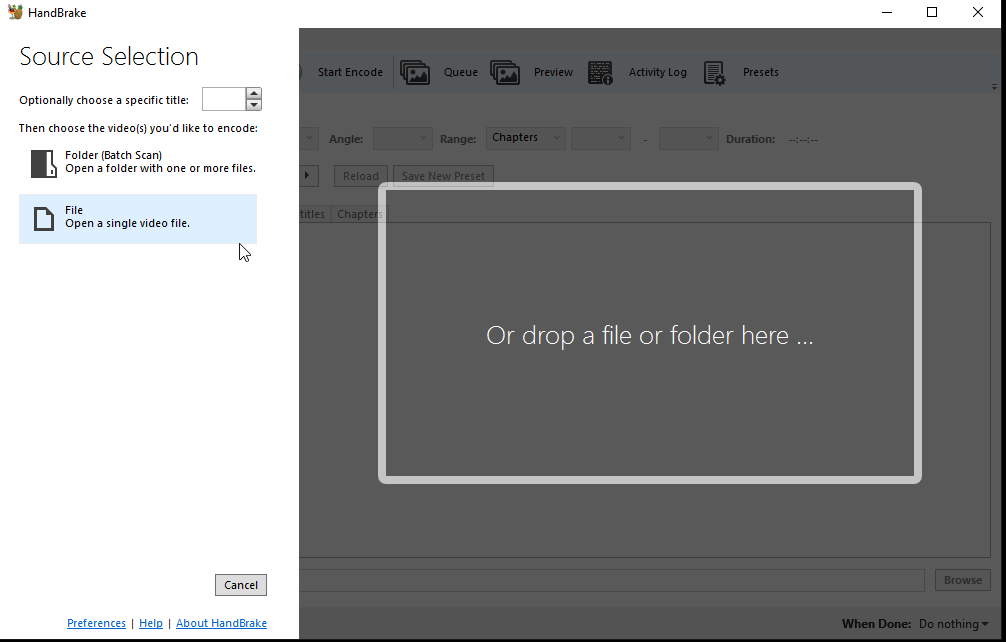

Simply double-clicking the file opens it. MP4 files open in the operating system's default video player. Many consider MP4 to be one of the best video formats available today. It is also a popular video format for streaming over the Internet, such as on YouTube. It is compatible with a wide range of devices and operating systems, using a codec to compress file size, resulting in a file that is easy to manage and store. MPEG-4 (MP4) is a container video format that can store multimedia data, usually audio and video. To resolve this issue, try VLC media player. Keep in mind that M4V is a container that holds various kinds of data, so if there is a problem opening the file, it usually means that data in the container (an audio or video codec) is not compatible with the device’s OS. It is also possible to open M4V files in other media players, such as Adobe Premiere Pro, Media Player Classic, and several others.
Convert m4v to mp4 handbrake bulk mac#
M4V files open on Windows or Mac operating systems, in Apple iTunes for Windows and Apple iTunes for Mac, respectively. While M4V files are very similar to MP4, they are designed for Apple products and Apple usually protects these files with FairPlay DRM. This results in a file that is easy to manage and store. It stores audiovisual and multimedia data into single file and uses a codec to compress file size. Also, make sure to set the "High" profile, which enables the encoder to use all bells and whistles and optimize the quality for a given bit rate.M4V is a container video format that is exclusively for Apple products. So, you could try with a Rate Factor of 19. Sane CRF values are from 19 to 24, where lower means "better". Just like "variable bit rate" for MP3: It will make sure to spend the bits on the video parts that need them and make the overall quality better - at the same file size. If you really have to re-encode, make sure not to set an average bitrate, but choose a Constant Rate Factor, which is something like "constant quality". In the ideal case, you would convert the video to an uncompressed video, which won't lose you any quality, but give you files of a dozen Gigabytes in size, even for a few minutes of video material. But then, the file size will be bigger as well. So, if you load your MKV video into Handbrake, and re-encode it with x264, the H.264 encoder Handbrake uses, store it in an MP4 container, you are going to lose quality no matter what, unless you set the bitrate or quality factor so high that you won't (really) see the difference. Often, you want to re-encode video when for example its dimensions change, or you need a specific bit rate to squeeze your video stream into, or your original video uses a codec that you can't play for whatever reason. This is because the original has already been compressed by throwing away information, and by doing it again you're introducing generation loss.
Convert m4v to mp4 handbrake bulk full#
You can (usually) not retain full quality when encoding a video that was already encoded. This will help you understand why changing containers works and why the containers MP4 and MKV have little to do with video codecs, actually. To understand why this is necessary, it's important to learn the difference between video codecs and containers. In this case, the codecs will be adapted to the output container. If this command does not work, and if your input uses the wrong codecs for the output container, you will probably have to re-encode. Also, subtitle format support for MP4 is different from MKV, and actually quite restricted, so this command may fail. However, there's a big caveat: this only works if the audio and video codecs are supported in the target (MP4) container, which is the case for H.264/H.265 and AAC, for example, but not for many others. There are also tools like MP4Box which can also create MP4 containers - the same exists for MKV with MKVtoolnix. You can swap containers easily with FFmpeg – you just have to tell it to copy the video and audio streams: ffmpeg -i input.mkv -c copy -map 0 output.mp4 This doesn't lose quality, and it'll be a much faster process. Since passthrough is not possible, ask yourself: Do I need to re-encode? If you only want to change the container from MKV to MP4, you usually don't need to encode anything, you just change the "wrapping" around the video. Do I have to re-encode? Couldn't I just swap the container? So, anytime you're changing containers with Handbrake, your video is going to get re-encoded, which means it a) takes time and b) may introduce quality loss. HandBrake is designed to be a video transcoder. Sorry, adding video passthrough is not planned. See also the respective feature request that would have enabled video passthrough: MKV to MP4 in your case), Handbrake will re-encode the video. When you're using Handbrake to convert from one container format to


 0 kommentar(er)
0 kommentar(er)
